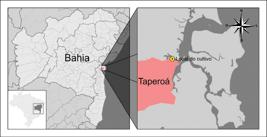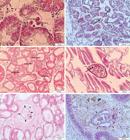In this work, parasites associated with the mangrove oyster Crassostrea rhizophorae were studied at a cultivation unit in the estuary of the Graciosa River in Taperoá, Bahia. On a monthly basis, between April 2011 and March 2012, 20 oysters were collected, measured and fixed in 10% formaldehyde. In order to identify the parasites, routine histological techniques were used. The specimens were embedded in paraffin and sections, 7 µm thick, were cut. These were then stained with Harris hematoxylin and eosin and were examined using an optical microscope. The parameters analyzed to investigate water quality showed that the temperature ranged from 23.9 °C to 29.3 °C, water salinity from 0.4 to 24.2 Practical Salinity Units PSU and recorded rainfall from 80 mm to 406.4 mm/month. During the parasitological analyses, infestation of the polychaete Neanthes succinea was observed in 41% of the oysters. Through histological techniques, the following parasites were identified: colonies of Rickettsia-like organisms (RLOs); the protozoa Nematopsis sp. and Ancistrocoma sp.; the turbellarian Urastoma sp.; the metacestode Tylocephalum sp. and an unidentified tapeworm. The data collected showed that there was low-intensity infection with and prevalence of parasites, except for Nematopsis sp., thus attesting that these cultivated oysters were in a healthy condition.
Histology; protozoa; Nematopsis sp.; Neanthes succinea; bivalves

 Thumbnail
Thumbnail
 Thumbnail
Thumbnail
 Thumbnail
Thumbnail


